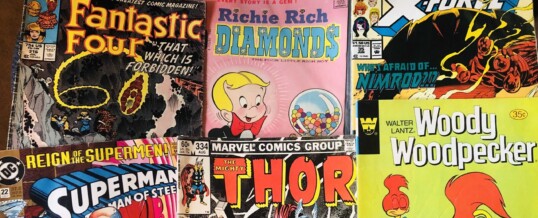
People use different ways to learn to read. Some folks use the vowels and consonants method. Others memorize how the words look.
I used both, but I had a secret weapon many didn’t know about.
Comic books.
While most kids were having, “Fun with Dick and Jane,” I was having a blast with Spider-Man and The Fantastic Four.
It started when my dad came home one day with a stack of comic books he’d picked up for a quarter at a garage sale.
At the time, new comics were 12¢ each, and were only available locally from a rack at the Piggly Wiggly in Ashdown, Arkansas.
But, thanks to the moms of the boys who were now out of the house, comics could be had by the sackfull for cheap. A summer garage sale after a good spring-cleaning was the best place to find them.
There were two major comic camps in the 60s and 70s: D.C. and Marvel.
D.C. gave us Superman, Batman, Wonder Woman, Green Lantern, and The Flash.
Marvel (the house that Stan Lee built) brought us Spider-Man, The Fantastic Four, Iron Man, The X-Men, Captain America, The Hulk, and Thor.
Since my youth, many other characters have come from Marvel and have made the company one of the most successful, not only in comics, but also in movies and associated marketing.
Comic characters are a serious, multi-billion dollar business.
Comic book lovers aren’t just nerdy kids with dissociative disorders (although I’ve met a few of those along the way); comic book lovers include just about all walks of life.
There’s no bigger fan of Superman than comedian Jerry Seinfeld. And lots of other well-known and successful people also love comics. They include TV host Seth Myers, and from Star Trek: The Next Generation, Patrick Stewart and Wil Wheaton. They played the captain and Wesley Crusher, respectively.
Many of the well-known comic character aficionados got hooked on them the same way my buddies and I did. We started reading comic books.
For me, comics were an escape. At a time when the Internet didn’t exist, and kids didn’t have a phone or a TV, you had to make your own entertainment. Or let Stan Lee do it for you.
And boy, did Stan Lee do a bang up job.
The reason my buddies and I leaned more towards Marvel than D.C. was that Stan Lee talked to us. In every comic, Stan wrote a message. And it was to us, the readers.
I have no idea who ran D.C. Comics back in the day, but everyone knew who Stan Lee was. And they still do now.
In my opinion, Stan Lee was one of the most brilliant marketing guys in American business. He made you feel as if the Marvel characters weren’t just your heroes, they were your buddies.
His trademark, “‘nuff said,” would end his messages, and they became his editorial trademark for the reader. His later appearances in Marvel movies became his trademark for those who were late to the game.
My buddies and I would talk about Stan Lee’s latest message as we sat around reading or trading comic books.
And trading comics was serious, and at times, intense.
The value of a comic could go up or down based on whether an old enemy of the comic hero had recently been killed off. If you had a copy of a previous appearance of that character, the value went up.
If you had copies of a comic where an enemy was considered lame, its trade value was less.
It wasn’t uncommon for three-or-four-to-one trades to occur. If you wanted a comic that was considered highly coveted, you might have to give up a stack of yours for it.
I played a lot of empty-lot, neighborhood sports with kids in town, and I traded a lot of comics. I don’t remember much about the baseball and football games we played, but I remember comic book trades very well.
As a matter of fact, I still have every comic book I ever had, less the ones I traded. They’re all in individual plastic sheaths, inside lightproof boxes, stored in a climate-controlled part of the house.
You see, my mom saw the difference comic books made in my youth. So when she was tired of them being in my old closet, she called me to come get them instead of selling them for a buck in a yard sale.
That makes my mom the biggest superhero of all.
‘Nuff said.
©2024 John Moore
John’s books, Puns for Groan People and Write of Passage: A Southerner’s View of Then and Now Vol. 1 and Vol. 2, are available on his website TheCountryWriter.com, where you can also send him a message.
JUN
2024
